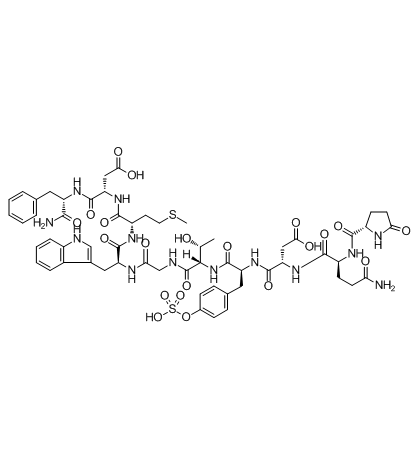17650-98-5
| Name | ceruletide |
|---|---|
| Synonyms |
L-Phenylalaninamide, O-sulfo-L-tyrosyl-L-threonylglycyl-L-tryptophyl-D-norleucyl-L-α-aspartyl-
caerulein 1.1 CERULETIDE FI-6934 CERULEIN EINECS 17650-98-5 Caerulein MFCD00076478 sulfated caerulein O-Sulfo-L-tyrosyl-L-threonylglycyl-L-tryptophyl-D-norleucyl-L-α-aspartyl-L-phenylalaninamide Ceosunin Ceruletide,Cerulein |
| Description | Ceruletide, a biologically active decapeptide isolated from the skin of the Australian frog Hyla caerulea, is a potent cholecystokinetic agent, and acts as a cholecystokinin receptor agonist. Sequence: {pGlu}-Gln-Asp-Tyr(SO3H)-Thr-Gly-Trp-Met-Asp-Phe-NH2;{pGlu}-QD-Y(SO3H)-TGWMDF-NH2. |
|---|---|
| Related Catalog | |
| Target |
Cholecystokinin receptor[4] |
| In Vitro | Ceruletide is similar chemically and biologically to the human gastrointestinal hormones cholecystokinin-pancreozymin (CCK) and gastrin II. Ceruletide stimulates gallbladder contraction, pancreatic exocrine secretion, gastric secretion, and motility in the distal duodenum, jejunum, ileum and colon, while delaying gastric emptying and inhibiting motility in the proximal duodenum[1]. Ceruletide in supramaximal but not in physiological doses activates NF-kappaB/Rel in vitro. This activation may induce a self-defending genetic program before the onset of cellular injury, which may prevent higher degrees of damage of pancreatic acinar cells after secretagogue hyperstimulation[2]. |
| In Vivo | Ceruletide (0.4-0.5 mcg/kg, i.v.; 3-4 mcg/kg, s.c.) results in emesis and evacuation of the bowel in the intact conscious dog, and recovery is complete 15-30 min after i. v. administration and 2-4 hr after s.c. administration. Ceruletide (5-15 ng/kg, i.v.) shows a marked spasmogenic effect on the pylorus of rats. Ceruletide also reduces blood pressure in anesthetized dogs[1]. Ceruletide serum bile acid (SBA) stimulation circumvents exogenous and endogenous influences associated with postprandial (PP) SBA stimulation. Ceruletide SBA stimulation may perform as well as PP SBA stimulation in dogs with portosystemic shunt (PSS) and be more sensitive for the detection of hepatic dysfunction in dogs with upper respiratory disease (URD)[3]. |
| Animal Admin | Dogs[3] All dogs undergo serum bile acid (SBA) stimulation with food (<5 kg/body weight [BW] 2 teaspoons, >5 kg BW 2 tablespoons) or 0.3 μg/kg BW Ceruletide IM, respectively, on consecutive days. A diet of moderate protein content and with an increased concentration of fiber is chosen to minimize metabolic complications such as hepatic encephalopathy. Before each test, the dogs are fasted for 12 hours. Blood samples are drawn at baseline, 60 and 120 minutes after feeding, and 20, 30, and 40 minutes postinjection, respectively. The blood samples are collected in plain tubes and left to clot; they are then centrifuged at 6,500 ×g for 1 minute, and the serum is used to measure SBA by a colorimetric test with endpoint determination[3]. |
| References |
| Density | 1.4±0.1 g/cm3 |
|---|---|
| Melting Point | 224-226° (dec) |
| Molecular Formula | C58H73N13O21S2 |
| Molecular Weight | 980.051 |
| Exact Mass | 979.374573 |
| PSA | 585.08000 |
| LogP | 2.46 |
| Index of Refraction | 1.632 |
| Storage condition | -20°C |
| Personal Protective Equipment | Eyeshields;Gloves;type N95 (US);type P1 (EN143) respirator filter |
|---|---|
| RIDADR | NONH for all modes of transport |
| WGK Germany | 3 |


